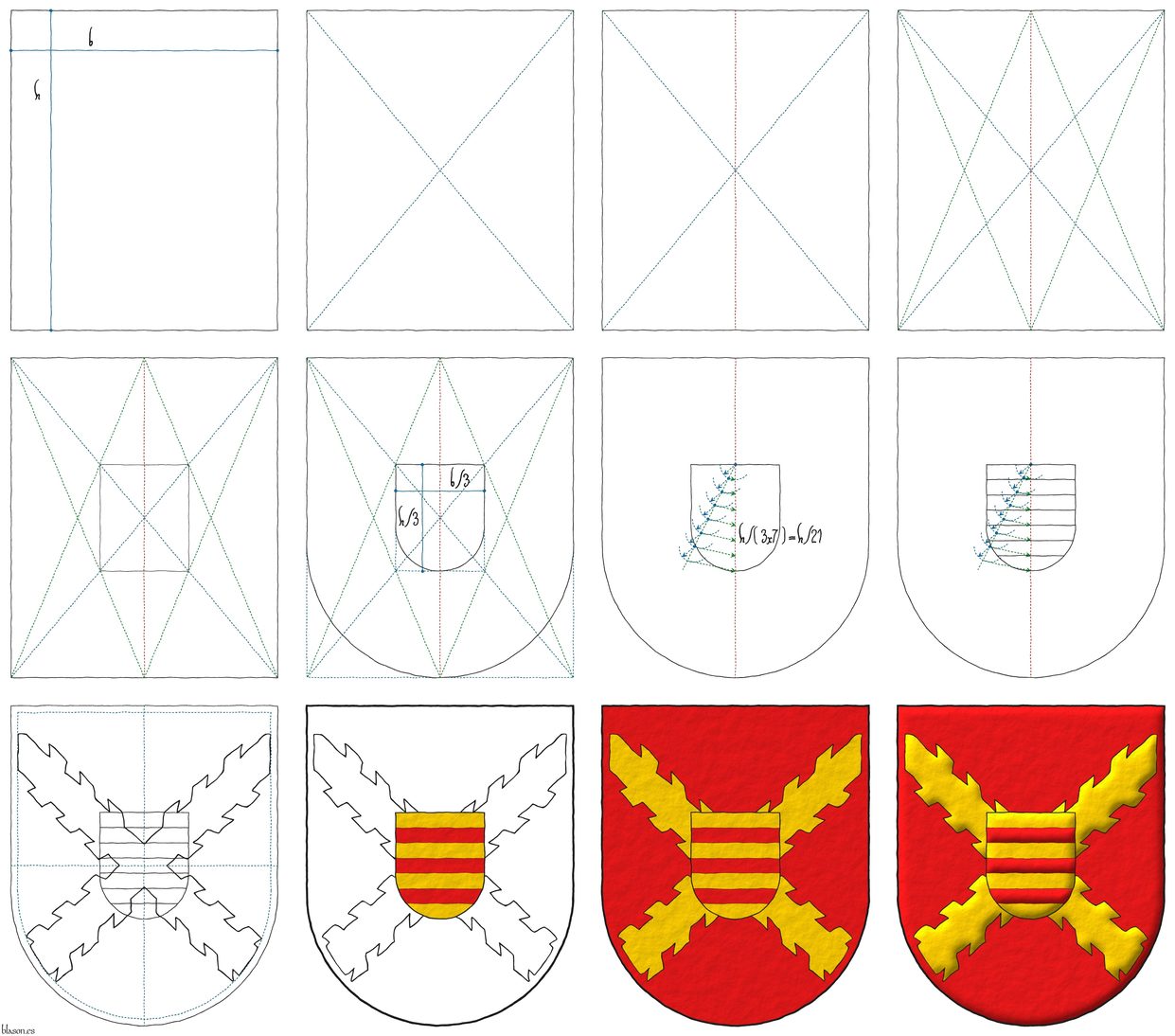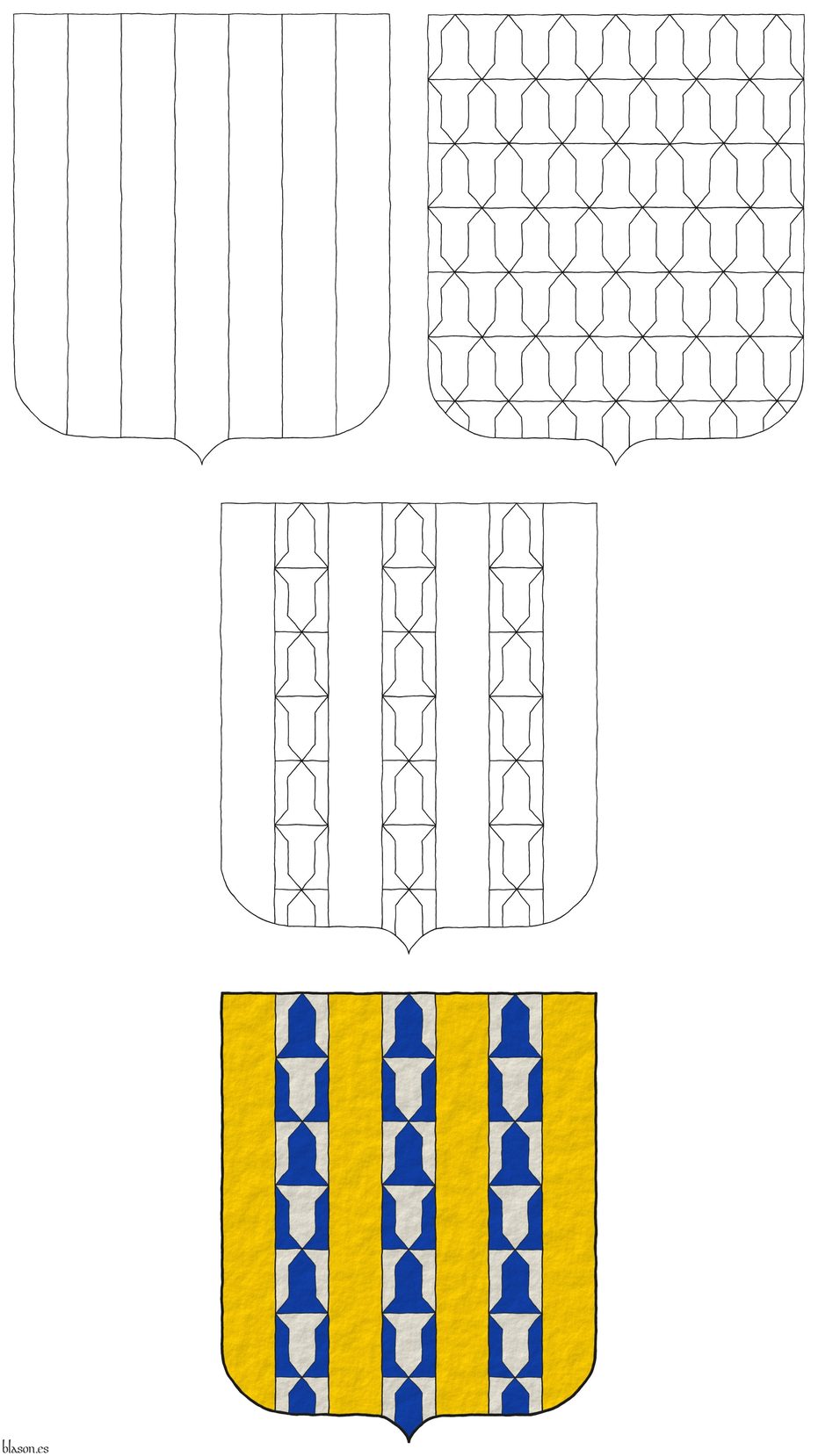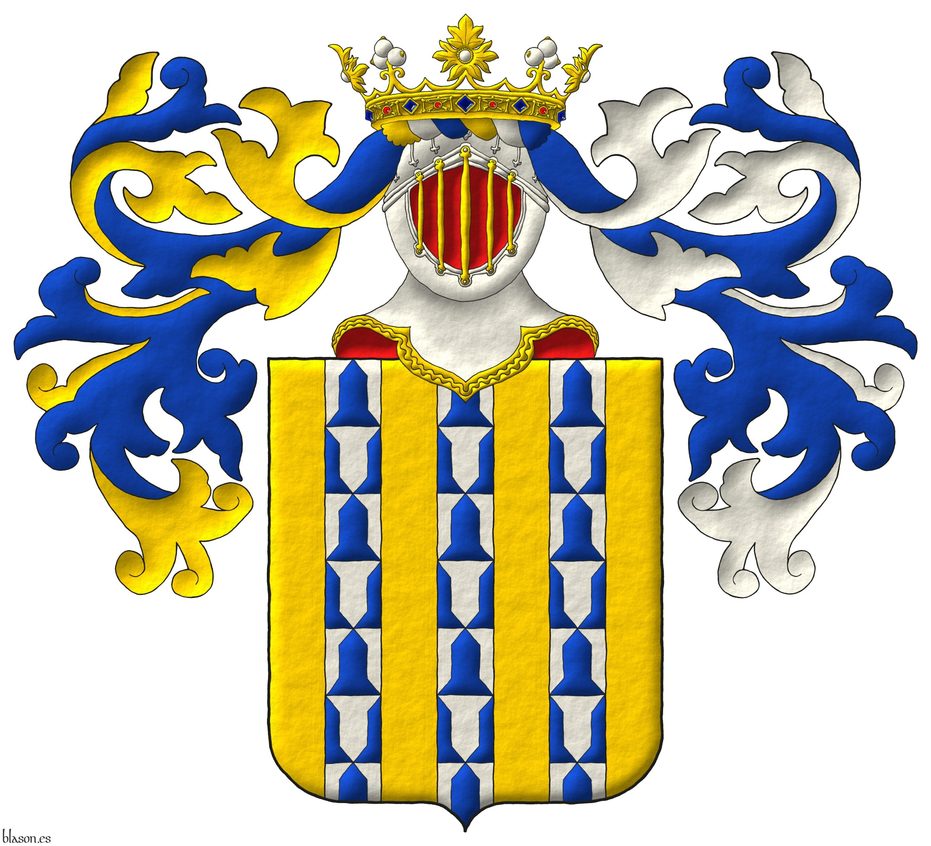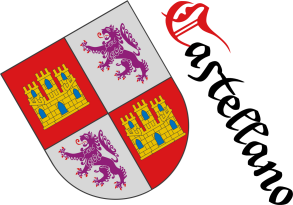
Tercio Alessandro Farnese
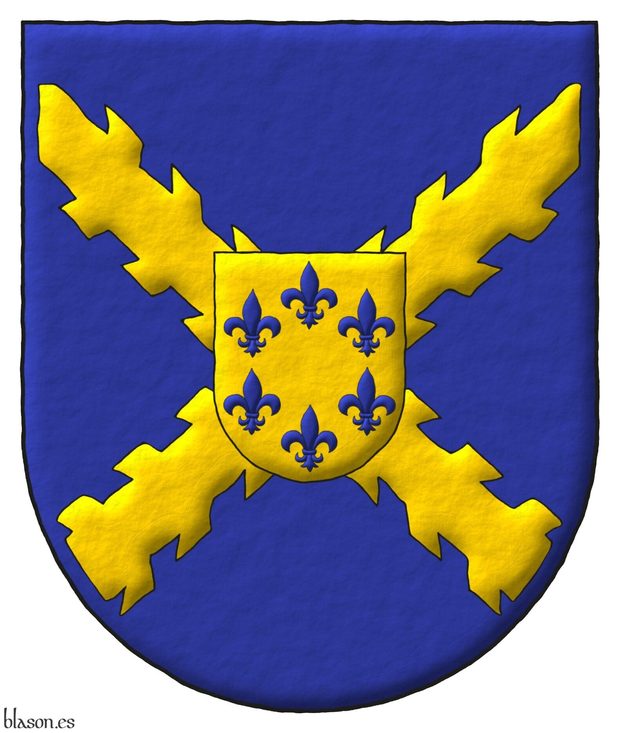
Azure, a cross of Burgundy Or; an inescutcheon Or, six fleurs de lis in orle Azure.
Escudo de azur, una cruz de Borgoña de oro; un escusón de oro, seis flores de lis en orla de azur.
Coat of arms interpreted by me, illuminated with lights and shadows, contoured in Sable, with a semi-circular external shape and with a freehand finishing.
Coat of arms of the Tercio Alessandro Farnese, 4th of the Spanish Legion, emblazoned by me. In honor of Alessandro Farnese, the central inescutcheon bears in orle the 6 fleurs de lis of the Farnese family.
Blazon keywords: Azure, Or, One, Six, Cross of Burgundy, Cross couped, Inescutcheon, Fleur de lis and In orle.
Style keywords: Outlined in sable, Illuminated, Semi-circular and Freehand.
Classification: Military, Interpreted, Boa and Coat of arms.
Bearer: Tercio Alessandro Farnese.


Tercio Great Captain, schema 3x4
Gules, a cross of Burgundy Or; an inescutcheon Or, three bars Gules.
Coat of arms of the Tercio Great Captain, 1st of the Spanish Legion, emblazoned by me in 12 steps. The inescutcheon represents the coat of arms of Gonzalo Fernandez de Cordoba, 1453-1515, «The Great Captain». To paint the coat of arms of the Tercio Gran Capitán, I applied a geometric method that involves dividing both the width and the height of the shield into three equal parts. This way, the central inescutcheon, bearing the arms of Gonzalo Fernandez de Cordoba, occupies exactly one third of the width and one third of the height of the main shield. Beyond its compositional function, this method also serves as a symbolic nod to the name of this historic military unit. The shield of the Tercio has been quite literally built using thirds. It is a small play on words and shapes that combines geometry with heraldic tradition.
Blazon keywords: Gules, Or, One, Three, Cross of Burgundy, Cross couped, Inescutcheon, Bar and Fess.
Style keywords: Ratio, Outlined, Outlined in sable, Plain tincture, Illuminated and Semi-circular.
Classification: Military, Interpreted, Schema, Boa and Coat of arms.
Bearer: Tercio Great Captain.


Tercio Great Captain, plain tincture

Gules, a cross of Burgundy Or; an inescutcheon Or, three bars Gules.
Arms interpreted by me, in plain tinctures, outlined in Sable, with a semi-circular outer contour and with a texturized finish.
Coat of arms of the Tercio Great Captain, 1st of the Spanish Legion, emblazoned by me. The inescutcheon represents the coat of arms of Gonzalo Fernandez de Cordoba, 1453-1515, known as «The Great Captain». It was Gonzalo Fernandez de Cordoba who reorganized the Spanish infantry, laying the foundations for what would later become the Tercios.
Blazon keywords: Gules, Or, One, Three, Cross of Burgundy, Cross couped, Inescutcheon, Bar and Fess.
Style keywords: Outlined in sable, Plain tincture and Semi-circular.
Classification: Military, Interpreted, Boa and Coat of arms.
Bearer: Tercio Great Captain.


Tercio Great Captain
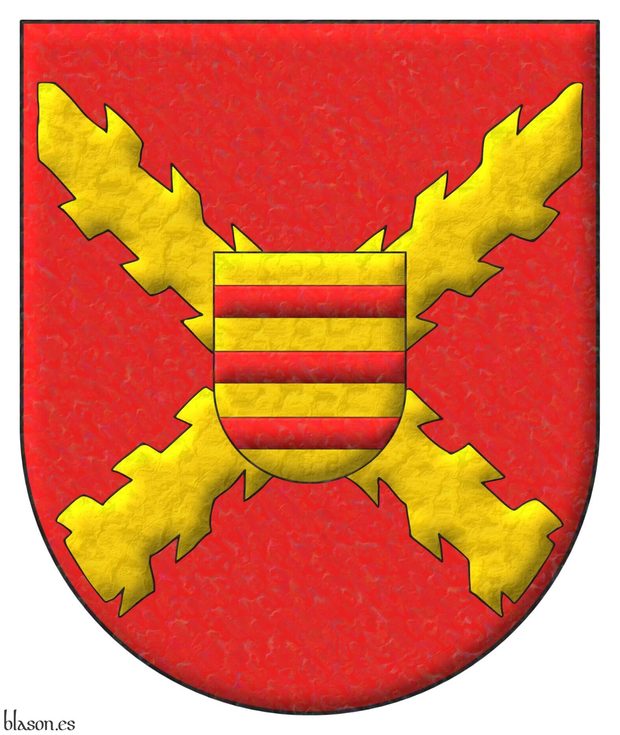
Gules, a cross of Burgundy Or; an inescutcheon Or, three bars Gules.
Escudo de gules, una cruz de Borgoña de oro; un escusón de oro, tres fajas de gules.
Arms painted by me, illuminated with lights and shadows, outlined in Sable, with a semi-circular outer contour and with a metal beaten finish.
Coat of arms of the Tercio Great Captain, 1st of the Spanish Legion, emblazoned by me. The inescutcheon represents the coat of arms of Gonzalo Fernandez de Cordoba, 1453-1515, known as «The Great Captain». During the Italian campaigns in the late 15th and early 16th centuries, especially during the wars of Naples, Gonzalo Fernandez de Cordoba reformed the Spanish army, adapting it to the new conditions of Renaissance warfare. He created a flexible tactical system based on the combination of pikemen, inspired by the Swiss; «espingarderos», forerunners of the arquebusiers; and «espadas» or shock troops, this combination would form the foundation of the future «Tercios».
Blazon keywords: Gules, Or, One, Three, Cross of Burgundy, Cross couped, Inescutcheon, Bar and Fess.
Style keywords: Outlined in sable, Illuminated, Semi-circular and Metal beaten.
Classification: Military, Interpreted, Boa and Coat of arms.
Bearer: Tercio Great Captain.


Marquis Prato di Arnesano, schema 3x2
Or, three pallets Vair.
The coat of arms of the Marquis Prato di Arnesano, requested by Andrea Tamburelli Lanzara and painted by me. When a field is charged with 3 pallets, it results in 7 vertical areas: 4 belong to the field, 1 on the dexter, 2 between the pallets, and 1 on the sinister, and 3 correspond to the pallets themselves. In most cases, and especially in the present one, it is ideal that these 7 areas be of equal width. This allows me to apply a fur pattern like vair using a 7 columns structure, with 7 little bells of vair in the chief, so that each pallet contains the same vair arrangement. In this case, for greater harmony, I have also arranged the vair in 7 rows, although this is not required. The figure illustrates this concept.
Blazon keywords: Or, Three, Pale and Vair.
Style keywords: Outlined, Outlined in sable, Plain tincture and Ogee.
Classification: Personal, Interpreted, Schema, Boa and Coat of arms.
Bearer: Prato di Arnesano, Marquis.


Marquis Prato di Arnesano, plain tincture

Or, three pallets Vair.
Arms depicted by me, in plain tinctures, contoured in Sable, with an ogee outer contour and with a texturized finishing.
The coat of arms of the Marquis Prato di Arnesano, requested by Andrea Tamburelli Lanzara and painted by me. Vair is a fur, and furs are repetitive combinations of a metal and a color. In the case of vair, the metal is Argent and the color is Azure. Because they simultaneously include both a metal and a color, furs are exempt from the rule of tincture, as they would inevitably violate it, either through their metal or color component. In this coat of arms, the pallets of vair lies on a field of metal Or, and it might be thought that the metal Argent in the vair breaks the rule. However, as mentioned, the rule of tincture does not apply to furs due to their dual nature.
Blazon keywords: Or, Three, Pale and Vair.
Style keywords: Outlined in sable, Plain tincture and Ogee.
Classification: Personal, Interpreted, Boa and Coat of arms.
Bearer: Prato di Arnesano, Marquis.


Prato di Arnesano, Marquis
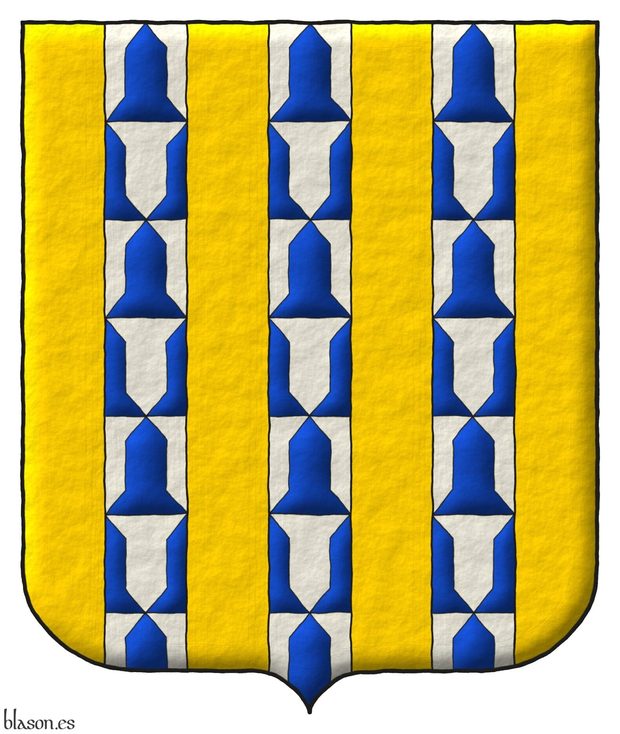
Or, three pallets Vair.
Escudo de oro, tres palos de veros.
Coat of arms interpreted by me, illuminated with lights and shadows, contoured in Sable, with an ogee external shape and with a freehand finishing.
The coat of arms of the Marquis Prato di Arnesano, requested by Andrea Tamburelli Lanzara and painted by me.
Blazon keywords: Or, Three, Pale and Vair.
Style keywords: Outlined in sable, Illuminated, Ogee and Freehand.
Classification: Personal, Interpreted, Boa and Coat of arms.
Bearer: Prato di Arnesano, Marquis.


Crest and mantling of the Marquis Prato di Arnesano
Or, three pallets Vair. Crest: Upon helm affronty Argent, barred Or, lined Gules, with a wreath Argent, Or and Azur, a crown of Marquis. Mantling: Dexter Azure doubled Or, sinister Azure doubled Argent.
Arms painted by me, highlighted with lights and shadows, contoured in Sable, with an ogee outer contour and with a freehand finishing.
The coat of arms of the Marquis Prato di Arnesano, requested by Andrea Tamburelli Lanzara and painted by me. That the base of the bevor is fimbriated Or is a detail I do not blazon, as I regard it purely as an artistic feature.
Blazon keywords: Or, Three, Pale, Vair, Crest, Upon (wreath), Helm, Affronty, Barred, Lined, Wreath, Crown of Marquis and Crown.
Style keywords: Outlined in sable, Illuminated, Ogee and Freehand.
Classification: Personal, Interpreted, Boa and Coat of arms.
Bearer: Prato di Arnesano, Marquis.

Continue with: Crown of the Marquis Prato di Arnesano.
-
Language
-
Categories of heraldry
-
Divisions of the field
- Without divisions
- Party per pale
- Party per fess
- Party per bend
- Party per bend sinister
- Tierce
- Tierce sinister
- Tierced per pale
- Tierced per fess
- Tierced per bend
- Tierced pallwise inverted
- Quarterly
- Quarterly per saltire
- Gyronny
- Party per fess, the chief per pale
- Party per pale, the sinister per fess
- Party per fess, the base per pale
- Party per pale, the dexter per fess
- Chapé
- Chaussé
- Embrassé
- Contre-embrassé
- Party per chevron
- Enté
- Enté en point
- Flanched
-
Metals
-
Colours
-
Furs
-
Other tinctures
-
Ordinaries and sub-ordinaries
-
Diminutives of the ordinaries
-
Geometric charges
-
Composite ordinaries
-
Inanimate charges from Nature
Atom, Crescent, Diamond, Emerald, Estoile, Increscent, Lightning flash, Moon, Mount, Mullet, Mullet of four points, Orbital, Plough of Ursa Major, Rainbow, Ray of the sun, River, Sea, Snowflake, Sun, Sun in splendour, Sun of May, Trimount, Water and Wave.
-
Vegetal charges from Nature
Acorn, Apple, Apple tree, Ash, Bluebonnet, Camellia, Chrysanthemum, Cinquefoil, Cornflower, Dogwood flower, Double rose, Elm, Fleur de lis, Flower, Gourd, Holm oak, Hop cone, Kapok tree, Laurel, Lily, Linden, Lotus flower, Madonna lily, Mexican cedar tree, Oak, Olive tree, Palm tree, Plantain plant, Pomegranate, Poplar leaf, Rose, Shamrock, Sunflower, Thistle, Tree, Tulip, Vine and Wheat.
-
Animal charges from Nature
Badger, Bald eagle, Barbel, Barn owl, Bear, Beaver, Beetle, Bighorn sheep, Blackbird, Boar, Brach hound, Bull, Doe, Dog, Dolphin, Dove, Eagle, Elephant, Falcon, Female figure, Fish, Flame, Fly, Fox, Frog, Goat, Goldfinch, Goose, Heron, Horse, Hummingbird, Jaguar, Lark, Leopard, Lion, Lion passant, Lion rampant guardant, Lioness, Lynx, Male figure, Martlet, Merino ram, Owl, Panther, Parrot, Peacock, Pelican, Pelican in her piety, Puffin, Quetzal, Raven, Roe deer, Rooster, Savage, Seagull, Serpent, She-wolf, Stag, Starling, Talbot, Tyger, Vulture, Warren hound and Wolf.
-
Parts of natural charges
Arm, Beak, Branch, Caboshed, Chest, Claw, Covert, Dorsal fin, Eagle claw, Ermine spot, Escallop, Feather, Foot (palmiped), Foreleg, Forepaw, Hand, Head, Heart, Hoof, Leaf, Neck, Ostrich feather, Palm frond, Paw, Roe deers' attires, Shoulder, Sprig, Stags' attires, Stem, Swallow-tail, Tail, Tail addorsed, Tail fin, Talon, Tooth, Trunk, Trunk (elephant), Two hands clasped, Two wings in vol, Udder, Wheat spike, Wing and Wrist.
-
Artificial charges
Ace of spades, Anchor, Anvil, Arch, Arm vambraced, Armillary sphere, Arrow, Axe, Bell, Bell tower, Beret, Bonfire, Book, Bookmark, Bow, Branding iron, Bridge, Broken, Buckle, Cannon, Cannon dismounted, Cannon port, Canopy roof, Carbuncle, Castle, Celtic Trinity knot, Chain, Chess rooks, Church, Clarion, Clay pot, Closed book, Club, Column, Comb, Compass rose, Conductor's baton, Cord, Covered cup, Crozier, Crucible, Cuffed, Cup, Cyclamor, Dagger, Double vajra, Drum, Ecclesiastical cap, Fanon, Federschwert, Fleam, Four crescents joined millsailwise, Galician granary, Garb, Gauntlet, Geometric solid, Grenade, Halberd, Hammer, Harp, Host, Hourglass, Key, Key ward, Knight, Knot, Lantern, Letter, Line, Loincloth, Menorah, Millrind, Millstone, Millwheel, Monstrance, Mortar, Mullet of six points pierced, Nail, Non-classic artifact, Norman ship, Number, Oar, Oil lamp, Open book, Page, Pair of scales, Parchment, Pestle, Piano, Pilgrim's staff, Plough share, Polish winged hussar, Port, Portcullis, Potent, Quill, Ribbon, Rosette of acanthus leaves, Sabre, Sackbut, Sail, Scroll, Scythe, Sheaf of tobacco, Ship, Skirt, Spear, Spear's head, Stairway, Star of David, Step, Sword, Symbol, Tetrahedron, Torch, Tower, Trident, Trumpet, Turret, Two-handed sword, Wagon-wheel, Water-bouget, Wheel, Winnowing fan and With a turret.
-
Immaterial charges
Angel, Archangel, Basilisk, Dragon, Dragon's head, Garuda, Golden fleece, Griffin, Heart enflamed, Justice, Mermaid, Our Lady of Mercy, Ouroboros, Paschal lamb, Pegasus, Phoenix, Sacred Heart of Jesus, Saint George, Sea-griffin, Trinity, Triton, Unicorn, Winged hand and Wyvern.
-
External elements
-
Heraldic creations
-
References
-
Formats
-
Keywords on this page
Azure, Boa, Bar, Wreath, Upon (wreath), Crest, Ogee, Crown, Crown of Marquis, Cross of Burgundy, Cross couped, Affronty, Outlined, Outlined in sable, In orle, Coat of arms, Inescutcheon, Schema, Fess, Fleur de lis, Lined, Personal, Barred, Gules, Illuminated, Interpreted, Semi-circular, Metal beaten, Military, Or, Pale, Prato di Arnesano, Marquis, Ratio, Six, Tercio Alessandro Farnese, Tercio Great Captain, Plain tincture, Freehand, Three, One, Vair and Helm.

